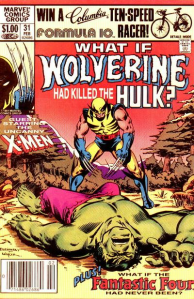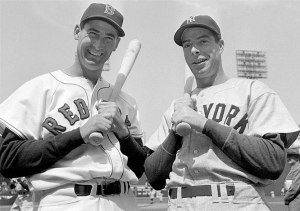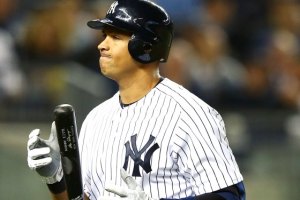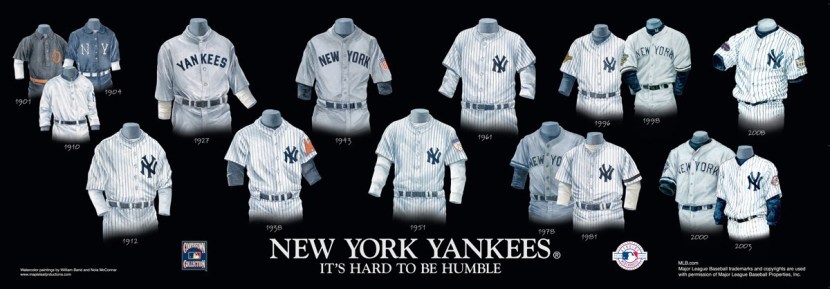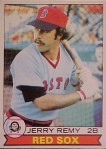Tagged: Mo Vaughn
Alex Rodriguez: What If..?
In Comic Books they are known as ‘What If?’ (Marvel) issues or ‘Elseworld’ (DC) tales, taking the established character out of their established norm and seeing what would have or could have happened if….
A decade later, we revisit called-off engagement between Rodriguez and Boston
From: Gordon Edes
They rank among the great what-might-have-been stories in Red Sox history.
What if an organization with a history of racial intolerance had given more than a sham tryout to Jackie Robinson or listened to the urgings of a scout named George Digby to sign a young outfielder named Willie Mays?

What if Red Sox owner Tom Yawkey had, in the cold light of morning, decided to follow through on the trade arranged over drinks the night before with Yankees co-owner Dan Topping, one in which the Sox would have swapped Ted Williams for Joe DiMaggio? (Note: This deal also was scuttled due to the Yankees reluctance to include a young catching prospect named Yogi Berra.)
And what if the Red Sox had succeeded in their audacious effort 10 years ago to acquire Alex Rodriguez, generally acknowledged as the best player in the game at the time, from the Texas Rangers?
Ten years ago Monday, Rangers owner Tom Hicks declared that effort “totally, totally dead.” He would soon send a letter to Rangers season-ticket holders pledging that Rodriguez would be the team’s shortstop on Opening Day 2004. Then, on Valentine’s Day, he traded him to George Steinbrenner’s Yankees.
With A-Rod now shamed and a shell of his former self, a player who went from being championed by the game’s ruling class to pariah, it is easy to regard Boston’s failed courtship as a blessing, a disaster averted.
But that’s with the benefit of hindsight. At the time, the Sox — and A-Rod — were bitterly disappointed that it did not come to pass, this deal first proposed by Hicks to the Red Sox within days of their crushing Game 7 loss to the New York Yankees in the 2003 ALCS.
 Hicks was looking to get out from under the game’s biggest contract, a $250 million, 10-year deal that in its first three years had not lifted the Rangers out of mediocrity. He asked for Nomar Garciaparra in return. The Sox countered by offering Manny Ramirez, whom they had placed on irrevocable waivers only weeks before without any takers.
Hicks was looking to get out from under the game’s biggest contract, a $250 million, 10-year deal that in its first three years had not lifted the Rangers out of mediocrity. He asked for Nomar Garciaparra in return. The Sox countered by offering Manny Ramirez, whom they had placed on irrevocable waivers only weeks before without any takers.
With that deal in play, Red Sox GM Theo Epstein made another at the winter meetings, arranging to trade Garciaparra to the White Sox for slugging outfielder Magglio Ordonez. That second trade was contingent on the A-Rod deal being approved, but when Epstein entered the hotel room of his new manager, Terry Francona, and rattled off a prospective lineup that included Johnny Damon, A-Rod, David Ortiz and Ordonez, on knees made unsteady by multiple surgeries, Francona climbed onto his bed and did an impromptu dance.
That same night, Epstein slipped out of the meetings in New Orleans and flew to New York to meet with Rodriguez and his then-wife, Cynthia. Owner John W. Henry had already met with the couple in Miami, granted extraordinary permission to do so by commissioner Bud Selig, who had run into Rodriguez at Sammy Sosa’s party in the Dominican Republic and listened to A-Rod earnestly express his desire to play for the Sox.
I was working for the Boston Globe at the time, and I, too, went to Miami to meet with Rodriguez. I liked him. He was smart, engaging and gracious. I believe he really wanted to play for the Sox. I had seen him when he’d made his major-league debut at Fenway as an 18-year-old from Miami, and I was impressed with his appreciation of Boston and what it would mean to his legacy if he would be the one who led the Sox to a World Series title after 86 years without one.
The deal was complicated and ultimately collapsed under its own weight. The Red Sox, for luxury tax reasons, wanted to reduce the value of Rodriguez’s contract by $4 million a year, a total of $28 million over the remaining seven years of his deal. That was a nonstarter for the union. Any reduction, the union lawyers said, would require “added benefits” from the Red Sox — like the Mets gave Mo Vaughn when they added two more teams to the no-trade provisions in his contract in exchange for a $500,000 reduction. The Sox tried to sell the union on an “added benefit” of allowing A-Rod the chance to opt out of his contract after two years and become a free agent, a proposal ridiculed by the union, which argued that A-Rod, because his contract was so much more than anyone else’s, probably would have been looking at a pay cut. They made a counteroffer the Sox deemed unacceptable.
Hicks, meanwhile, was seeking some immediate financial help and not only wanted the Sox to assume A-Rod’s contract, but pay a portion of Ramirez’s deal so that he could pursue some pitching in free agency. That was not going to happen. But on his own, A-Rod contacted Hicks and offered to pay, out of his own pocket, the $15 million Hicks wanted from the Sox. That’s how badly he wanted to come to Boston.
By the end of talks, there were bruised feelings on all sides. Henry was upset that 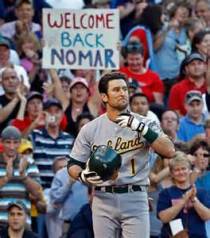 Hicks had made little effort to keep negotiations quiet. Hicks was furious with Sox CEO Larry Lucchino, to the point that Tom Werner became the Sox point man with the Texas owner. Lucchino and union lawyer Gene Orza took whacks at each other. Garciaparra never recovered from the shock of learning that the Sox had sought A-Rod, even as Henry later explained he initially thought that they could have co-existed. And A-Rod resigned himself to remaining with the Rangers.
Hicks had made little effort to keep negotiations quiet. Hicks was furious with Sox CEO Larry Lucchino, to the point that Tom Werner became the Sox point man with the Texas owner. Lucchino and union lawyer Gene Orza took whacks at each other. Garciaparra never recovered from the shock of learning that the Sox had sought A-Rod, even as Henry later explained he initially thought that they could have co-existed. And A-Rod resigned himself to remaining with the Rangers.
The upshot, of course, is that the Sox won two World Series in the next four seasons without A-Rod, and won their third in the 10 seasons in which Rodriguez has been a Yankee. And A-Rod alienated his longtime friend Derek Jeter, the first of many soap operas that would mark his time in New York. And then came the PED revelations.
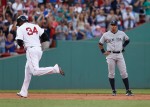 That part of the story, sadly, would have been no different had he played for the Red Sox instead of the Yankees. But the rest of it? Ten years later, I still believe it could have gone a different way for A-Rod in Boston. Instead of a wary Jeter, he would have been embraced by David Ortiz, who remains one of his good friends in the game. He also was very close with Ordonez, who would have combined with A-Rod to more than compensate for the loss of right-handed power Ramirez represented.
That part of the story, sadly, would have been no different had he played for the Red Sox instead of the Yankees. But the rest of it? Ten years later, I still believe it could have gone a different way for A-Rod in Boston. Instead of a wary Jeter, he would have been embraced by David Ortiz, who remains one of his good friends in the game. He also was very close with Ordonez, who would have combined with A-Rod to more than compensate for the loss of right-handed power Ramirez represented.
He would have remained at short, where his value to the club would have been greater than it was to the Yankees at third.
In his first five seasons with the Yankees, through the 2008 season, Rodriguez hit 208 home runs. No one in baseball hit more. And Fenway is much kinder to right-handed hitters than Yankee Stadium. He was one of 10 players who had an on-base percentage greater than .400 in that time. He averaged 6.8 in WAR in that time.
Call me naïve, but I think Boston would have brought out the best in him, and he would have been loved for it.
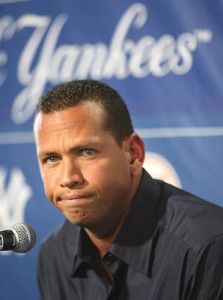 We’ll never know, of course. And in this town, I am well aware, that’s hardly a popular thought. But there’s a part of me that has never forgotten the shining promise of that 18-year-old and laments that it has ended the way it has.
We’ll never know, of course. And in this town, I am well aware, that’s hardly a popular thought. But there’s a part of me that has never forgotten the shining promise of that 18-year-old and laments that it has ended the way it has.
_____
On a personal note: I was at that same game, just a few rows up and sitting between home and the visitors dugout (best seats I ever scored) for that Fenway game where an 18-year-old Alex Rodriguez debuted for Seattle. I sat close enough to see all the awe and wonder on the face of a kid who was walking out into a Cathedral to take his first big league swings. My how times changed as he was on his way to Texas!
Before the PED’s, before the even more inflated ego and sense of entitlement, I was not a fan of the proposed trade. I was a Nomar guy. I didn’t dislike A-Rod at that point, I just disliked the perceived greed and the monster contract and the handcuffs that came with it. How could you as a team hit the free agent market for pitching and additions under those circumstances? Yeesh! Sure the Yankees did it and eventually put a World Series ring on A-Rod’s finger, but we won two in the same amount of time and of course just added the third.
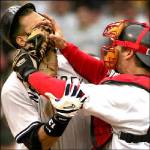 Would or could any of that have happened if we found A-Rod under the tree for Christmas of 2003? Maybe a ring… two at an outside chance? Luckily, this is one of those Scarlett Hose / Bronx Bombers hypotheticals we don’t have to put too much emphasis on… after all, we came out for the better.
Would or could any of that have happened if we found A-Rod under the tree for Christmas of 2003? Maybe a ring… two at an outside chance? Luckily, this is one of those Scarlett Hose / Bronx Bombers hypotheticals we don’t have to put too much emphasis on… after all, we came out for the better.
“No prize for 2nd place….”
 But if there was, Jacoby Ellsbury definitely deserved it.
But if there was, Jacoby Ellsbury definitely deserved it.
Sure, people will be debating this one for a while, but in the end, Justin Verlander had himself a fantastic season. But, so did Pedro Martinez in 1999. In fact, looking back at the various stats and research, Pedro had a better over all pitching season in 1999… but wasn’t voted the first starting pitcher since ‘The Rocket’ Roger Clemens in 1986 to win both the Cy Young and MVP awards in a single season.
That, I have a problem with.
- 1999 Pedro Martinez 2011 Justin Verlander
- ERA 2.07 2.40
- Wins 23 24
- Losses 4 5
- K’s 313 250
- WHIP .923 .920
- BB 37 57
- Innings 213.1 251
- WAR 8.3 8.5
Yes, Verlander threw his second career No-Hitter and was the American League’s answer to Roy Halladay, Cliff Lee and eventually Clayton Kershaw. However, Pedro pitched a SABRmetric statistically stronger season in the midst of the steroid era, a season which again  saw combined league home run totals reach new records, had that Hall of Fame inning in the All-Star Game at Fenway and was the American League’s answer to Randy Johnson.
saw combined league home run totals reach new records, had that Hall of Fame inning in the All-Star Game at Fenway and was the American League’s answer to Randy Johnson.
Both won the American League pitching Triple Crown.
Both led their respective teams to 90 plus win seasons (and both made it to the ALCS)
Pedro finished 2nd in the BBWAA voting, with 8 First place votes (1 more than winner Ivan Rodriguez) and was intentionally left off 2 ballots cast.
Many of the ‘experts‘ who have spent weeks of expensive air-time on both radio and television debating the issue and who now proclaim “Well, now the precedent has been set” must be either retarded or just stupid. Verlander is one of several pitchers to win both awards including Kofax, Fingers, Blue (also the last switch-hitter to win an MVP), the aforementioned Clemens and most recently Dennis Eckersley. No, the precedent wasn’t set, it was just another salvo in the argument of ‘everyday’ players versus pitchers and the qualified standards of being ‘Most Valuable Player’. Of course, a lot of these experts are the same who contend that the award is not a popularity contest…. really? Ask Albert Bell about that… I’m sure he remembers who won the award in 1995.
1999 Nomar 1999 Ivan Rodriguez 1999 Manny 2011 Ellsbury 2011 Adrian Gonzalez 2011 Pedroia
AVG .357* .332 .333 .321 .338 .307
HR 27 35 44 32 27 21
RBI 104 113 165 105 117 91
OPS 1.002 .914 1.105 .928 .957 .861
SB 14 24 2 39 1 26
WAR 6.5 6.0 8.0 7.2 6.9 6.8
In ’99, Manny Ramirez, who had a statistically greater year with Cleveland than MVP winner Pudge Rodriguez did in Texas, finished third in the BBWAA voting behind Pedro. Nomar, winning the first of two consecutive batting titles, finished seventh while all played for 90 plus win playoff bound teams. This year, Ellsbury finished a solid second ahead of Toronto’s Jose Bautista (who’s 2nd half of the season really didn’t merit his finishing ahead of Granderson, Cabrera or perhaps even A-Gon) third place finish. Adrian Gonzalez in his first year with the Scarlett Hose finished seventh and I’m including Petey who came on strong in the 2nd half to accumulate a ninth place vote.
If anything, I think many will agree that the Red Sox collapse in September weighed like an anvil on Jacoby’s chances, which is unfortunate given he was one of the few players (Adrian’s ‘power outage’ but sustained average) who thrived during the season ending swoon. If the Sox had won just two more games, this blog post might just be moot.
With the age of Moneyball in what some have deemed its ‘twilight’ (especially under the terms of the new CBA) and the Bill James Sabermaticians now fully entrenched throughout MLB, more and more statistically curious tidbits of information continue to hit the mainstream. For example: Babe Ruth, arguably one of Baseball’s greatest players (as compared to marquee draw), won his only MVP award in 1923 (keep in mind it was a ‘league’ award as compared to the defunct Chalmers Aw ard and pre-dated the current BBWAA MVP Award). Using todays metrics… Ruth should have taken the award 12 times. That’s eleven more times than he actually won it and all based on his actual factual numbers. Shout out to Brian Kenny on MLB Network’s Clubhouse Confidential for combing through the blinding historical numbers and keeping it entertaining. Would love to see his team take a look at Ted Williams lifetime stats.
ard and pre-dated the current BBWAA MVP Award). Using todays metrics… Ruth should have taken the award 12 times. That’s eleven more times than he actually won it and all based on his actual factual numbers. Shout out to Brian Kenny on MLB Network’s Clubhouse Confidential for combing through the blinding historical numbers and keeping it entertaining. Would love to see his team take a look at Ted Williams lifetime stats.
Welcome back Double D…
I guess as the saying goes… “We almost forgot about you, but that’s probably because you’re almost forgotten.”
As many of us in The Nation know, even if you did listen to all that Theo hype as he accepted the move to Chicago, Dan Duquette was the man who (seemingly under the cone silence) built the foundation for the 2004 World Champion Red Sox. Sure, Theo took her to the prom and Tito Francona helped deliver two of her children but Dan Duquette was the first to get into her pants and knock her up.
In a span of two days… a millisecond on the Hot Stove clock, Dan interviewed, re-interviewed, was offered and accepted the offer from the Baltimore Orioles to take over as chief of Baseball Operations / General Manager (full details not yet announced). Now, I think Double D is a smart baseball guy, sure he’s not too keen with the media (doesn’t have to be) but does his job and backs it up. Maybe that’s why I don’t quite get it.
First, let’s take a brief look at his credentials.
The Montreal Expositions: In 1987 he became Montreal’s director of player development and drafted players such as Marquis Grissom, Cliff Floyd and Rondell White while also signing Vladimir Guerrero, Javier Vazquez and Orlando Cabrera to name a few. Duquette replaced Dave Dombrowski as Expos’ GM in September of 1991, going on to acquire elite pitchers Ken Hill, John Wetteland, Jeff Shaw and traded for Pedro Martínez from the Dodgers for second baseman Delino DeShields. Duquette also built the infamous ’94 Expos team which had the best record in baseball at the time of the 1994-95 Major League Baseball strike.
The Boston Red Stockings: Duquette became the GM of his hometown Red Sox and built a baseball operations  department which was upgraded at every level during his tenure with favorites such as Nomar Garciaparra and Kevin Youkilis being drafted into the system. Other notable draftees included future MLB shortstops David Eckstein, Adam Everett and Hanley Ramirez as well as
department which was upgraded at every level during his tenure with favorites such as Nomar Garciaparra and Kevin Youkilis being drafted into the system. Other notable draftees included future MLB shortstops David Eckstein, Adam Everett and Hanley Ramirez as well as second baseman Freddy Sanchez. The Sox traded over 35 players in Duquette’s farm system to staff the team including LHP Jorge De la Rosa who was traded for Curt Schilling and the afore-mentioned Hanley Ramirez who was later traded to the Marlins for Josh Beckett. Duquette is also noted for several major acquisitions that would ultimately play a part in the Red Sox 2004 World Championship, including knuckleballer Tim Wakefield in 1995, Pedro Martínez acquired from Montreal in 1997 as well as the 1997 trade with Seattle for both pitcher Derek Lowe and All-Star catcher Jason Varitek, the free agent signings of Manny Ramírez in 2000 and Johnny Damon in December 2001…
second baseman Freddy Sanchez. The Sox traded over 35 players in Duquette’s farm system to staff the team including LHP Jorge De la Rosa who was traded for Curt Schilling and the afore-mentioned Hanley Ramirez who was later traded to the Marlins for Josh Beckett. Duquette is also noted for several major acquisitions that would ultimately play a part in the Red Sox 2004 World Championship, including knuckleballer Tim Wakefield in 1995, Pedro Martínez acquired from Montreal in 1997 as well as the 1997 trade with Seattle for both pitcher Derek Lowe and All-Star catcher Jason Varitek, the free agent signings of Manny Ramírez in 2000 and Johnny Damon in December 2001…
… In 1996 Duquette signed Jaime Moyer to a free agent contract and then traded him to Seattle for outfielder Darren Bragg when manager Kevin Kennedy didn’t pitch him much and Moyer expressed he didn’t like playing in Boston. Moyer went on to win 139 games in just over 9 seasons with the Mariners and achieved over 250 wins in his career…
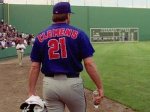 … Duquette is also famously known for his quote about Roger Clemens in which he said that “we had hoped to keep him in Boston during the twilight of his career” in 1996 after Clemens left as a free agent following a 39-40 record over his last four seasons pitching in Boston (Clemens remains under indictment for lying to Congress that he used performance enhancing drugs (PED’s) beginning in the period immediately following his departure from Boston to Toronto) …
… Duquette is also famously known for his quote about Roger Clemens in which he said that “we had hoped to keep him in Boston during the twilight of his career” in 1996 after Clemens left as a free agent following a 39-40 record over his last four seasons pitching in Boston (Clemens remains under indictment for lying to Congress that he used performance enhancing drugs (PED’s) beginning in the period immediately following his departure from Boston to Toronto) …
… The free agency losses of Clemens and first baseman Mo Vaughn were major points of discontent amongst some Red Sox fans, while he also did not resign Jose Canseco or Mike Greenwell (all of which proved to be wise moves).
So, you take the good and take the bad and there you have Dan Duquette.
Now, Dan has been removed from MLB since he was relieved of his duties by the Red Sox in 2002 following the sale to John Henry & Co. from the JRY Trust… so one might wonder, why now? Was it all this ‘Theo’ talk which made the sports talk rounds and saw miles of footage on ESPN, MLB Network and so on? Is it envy to the fact that when the experts say “Theo inherited a great team…” that the same experts usually omit the ‘from Dan Duquette’ part? I only ask because it is a very well-known fact that the Baltimore Orioles are, in todays vernacular, a Hot Mess.
Peter Angelos has, on many occasions, been regarded as a baseball owner you don’t want to work for and backed up by the fact that supposedly one or two candidates just recently declined the team’s offer for the GM position. Since he took over the team and put ‘his stamp on it’ way back in 1993 the O’s have, for the most part, sucked. Aside from the consecutive playoff years of ’96 & ’97, the Orioles have done little more than show up and trade marketable talent to bigger market teams who can pay the younger rising stars. Sure they sign older, declining stars with a possible upside who might put a few a$$es in the seats, but have done little to surround them with talent.
However…. Double D is taking over a young and fairly potent Orioles team which has shown streaks of brilliance in the last two seasons. With Buck Showalter already in place he has a manager who has mentoring and seasoning the kids as needed and has them ready for a real push in 2012. Can he find the veteran peices to compliment them? Well, since the budget in O-Town doesn’t look to be expanding, Dan will have to use his documented prowess to trade (or in some cases steal) or sign a few of those possible Wakefields and Pedro’s.
Baseball in general, nevermind in front-office dynamics, has changed in his decade away. He’ll have a limited pocketbook and a meddling owner to deal with as he tries to turn one of baseball’s oldest teams around and feed a starved fan base who’s turned, ironically, to the former Montreal Expos franchise residing in Washington D.C. in the guise of the Nationals. I’d wish him luck, but he’s back in the AL East and that’s just too bad.
“Same Old Song and Dance…”
To borrow a phrase from a slightly popular local music group…. It is indeed the same old song and dance, just different dance partners. Or to put in easier terms, “Same sh!t, different day”.
Anyone who is a ‘real‘ fan of the Red Stockings, meaning a member of the Nation since the dark days long before 2004, already know what all of this is. Red Sox ownership in their version of Spin Control. Sure, their Doctors of Spin are the equivalent of a mentally defective monkey humping a baseball but they apparently get the job done.
Regimes change, the excuses stay the same.
Has there been a need for this nuclear warfare in the aftermath of ‘The Collapse’? Of course not. Francona fell on the sword, took the blame and left town. Ah, but he do it in the way he was told to? Apparently not. Tito alluded to the problems which arose in the clubhouse (which the owners also alluded to) and the fact he was tuned out… but then dropped that little ticking time bomb of “I wasn’t sure the owners had my back…” And the Mass Destruction of Terry Francona had begun. Sinfully Disgraceful may be the only way to put it. Unnamed sources, personal matters… all disgusting. Of course they’re unnamed sources, they’re rats running about the sinking ship on fire trying to burn whatever they can for their masters in hopes of keeping their job once the flames are put out and the ship is righted. And the press? Using this fairly unconfirmed personal information about Tito’s mental health, medication and then his unfortunately distressed marriage? Well, the Boston press has been heavy-handed and taking liberties ever since Paul Revere proclaimed that little warning about the oncoming British. Especially the Boston Sports Press, which is a blessing and a curse as they are the best at what they do from both sides of the spectrum. And whose to say that even if the Sox hadn’t collapsed, if they made a decent run or perhaps won it all that Theo wasn’t leaving? The Cubs think he’s a hot commodity following the epic September fail? Imagine what hot sh!t Theo would have been if they’d won? This has been coming (remember the off-season back in the ’05-’06 days when he quit the job, took a vacation and then came back? It was because he was tired of having his toes stepped on…), it just didn’t have to end like this.
Or if history has shown us, maybe it did.
Let’s look at Boston’s divorce history (Bill Buckner, Manny and Grady Little aside). Pedro and Derek Lowe and even Johnny Damon pale in comparison to that nutty, paranoid Nomar. Then there’s Mo Vaughn and his drunken, truck flippin’ hung-over stripper lovin’ self. Wade Boggs defection to the Bronx  Zoo was fairly quiet compared to The Rocket who was a drunk, fat bastard in the twilight of his career (remind you, he hadn’t hit the juice yet… and is still a bastard) or even the ousting of Joe Morgan. Dewey had a fairly amicable split for an in-house legend, unlike Jim Rice or Yaz. The 1970’s and early ’80’s was basically a huge divorce gone bad… Bill Lee, George Scott, Fergie Jenkins, Louis Tiant, Eck and let’s not forget Pudge Fisk. Of course the Patron Saint of the Red Sox, Johnny Pesky, could tell you how complimentary everyone was when Teddy Ballgame left town. Not cause h
Zoo was fairly quiet compared to The Rocket who was a drunk, fat bastard in the twilight of his career (remind you, he hadn’t hit the juice yet… and is still a bastard) or even the ousting of Joe Morgan. Dewey had a fairly amicable split for an in-house legend, unlike Jim Rice or Yaz. The 1970’s and early ’80’s was basically a huge divorce gone bad… Bill Lee, George Scott, Fergie Jenkins, Louis Tiant, Eck and let’s not forget Pudge Fisk. Of course the Patron Saint of the Red Sox, Johnny Pesky, could tell you how complimentary everyone was when Teddy Ballgame left town. Not cause h e was here but because he was Ted’s friend and had a front row seat. (I’ll omit Babe Ruth because most of his behavior was, in fact, dead on juvenile delinquent true.)
e was here but because he was Ted’s friend and had a front row seat. (I’ll omit Babe Ruth because most of his behavior was, in fact, dead on juvenile delinquent true.)
Notice a lot of these names… they’re part of the lore. All easily recognized by one name. Ted. Fisk. Yaz. Rice. Rocket. Nomar. Pedro. Theo. Tito. The Red Sox are the embodiment of that old adage, “You build your heroes up just to tear them down.” But they’re hardly alone.
So, to David Ortiz (yeah, I’ll say it) and all you bandwagon Yankees fans (because the actual fans already know how it works) who want to remind us of the class and swagger a dynasty carries… f*@% you. Stop trying to take the ‘high road’ by ignoring the Steinbrenner Era or the legacy the Sons of Steinbrenner have already forged. Ask Dave Winfield, Don Mattingly, Joe Torre or most recently Mo Rivera or ‘Mister Yankee’ himself Derek Jeter. Yeah, the ‘Bombers have never had drama or been a soap opera… jacka$$.
David Ortiz (yeah, I’ll say it) and all you bandwagon Yankees fans (because the actual fans already know how it works) who want to remind us of the class and swagger a dynasty carries… f*@% you. Stop trying to take the ‘high road’ by ignoring the Steinbrenner Era or the legacy the Sons of Steinbrenner have already forged. Ask Dave Winfield, Don Mattingly, Joe Torre or most recently Mo Rivera or ‘Mister Yankee’ himself Derek Jeter. Yeah, the ‘Bombers have never had drama or been a soap opera… jacka$$.
Are the Sox still an elite team? Yes. Do they still have the talent to contend? Yes. Do they still have an ownership group committed to winning? No wins, no money.. so Yes. Is it time to change the ‘make-up’ of the team. Yes. But these are matters, some of them possibly drastic, best saved for the GM and field Manager… oh, wait.
I think at the end of the day, all the real fan can do is wish Theo all the best in Chicago (we’ll see you next season at Wrigley) and thank both he and Tito for everything they did to bring two WS titles home. Same to a number of faces from the wonderful October of 2004 which may be joining them… Papi, Wake and Tek.
Same Old Song and Dance.
Hall of Famer’s who wore Red Sox….
This installment of the investigative process will focus on members of the National Baseball Hall of Fame who have been members of the storied Scarlett Hose, obviously with a bit more focus on those who are enshrined with the ‘B’ on their cap.
members of the storied Scarlett Hose, obviously with a bit more focus on those who are enshrined with the ‘B’ on their cap.
So here is the over all list….
… Players listed in bold are enshrined with the Red Sox ‘B’ upon their cap.
| Player | Years played with the Red Sox |
|---|---|
| Luis Aparicio | 1971-73 |
| Wade Boggs | 1982-92 |
| Lou Boudreau | 1951-52 |
| Jesse Burkett | 1905 |
| Orlando Cepeda | 1973 |
| Jack Chesbro | 1909 |
| Jimmy Collins | 1901-07 |
| Joe Cronin
Andre Dawson |
1935-45
1993-94 |
| Bobby Doerr | 1937-44, 1946-51 |
| Dennis Eckersley | 1978-84, 1998 |
| Rick Ferrell | 1934-37 |
| Carlton Fisk | 1969, 1971-80 |
| Jimmie Foxx | 1936-42 |
| Lefty Grove | 1934-41 |
| Harry Hooper | 1909-20 |
| Waite Hoyt | 1919-20 |
| Fergie Jenkins | 1976-77 |
| George Kell | 1952-54 |
| Heinie Manush | 1936 |
| Juan Marichal | 1974 |
| Herb Pennock | 1915-22 |
| Tony Perez | 1980-82 |
| Jim Rice | 1974-89 |
| Red Ruffing | 1924-30 |
| Babe Ruth | 1914-19 |
| Tom Seaver | 1986 |
| Al Simmons | 1943 |
| Tris Speaker | 1907-15 |
| Dick Williams | 1963-64 |
| Ted Williams | 1939-42, 1946-60 |
| Carl Yastrzemski | 1961-83 |
| Cy Young | 1901-08 |
A few notes: Jimmy Collins does not have a cap in his HOF plaque, however the Hall lists his primary team as Boston. Andre Dawson was omitted from the official Red Sox listing of former Sox in the HOF, however I’m including him because he did in fact play there… I saw it, with my own eyes. Jimmie Foxx is enshrined wearing a Red Sox cap, however the Hall, and rightfully so, recognizes his primary team as the Philadelphia Athletics… the same can be said of Lefty Grove.
And here is the official recording of the retired numbers (excluding Jackie Robinson’s #42 retired by Major League Baseball for the simple fact he was not a member of the Boston Red Sox, even if historically he probably should have been)…
The retired Red Sox numbers, along with Jackie Robinson’s #42 that was retired by Major League Baseball in 1997, are posted on the right field facade in Fenway Park.
The Red Sox policy on retiring uniform numbers is based on the following criteria:
- Election to the National Baseball Hall of Fame
- At least 10 years played with the Red Sox
Bobby Doerr – #1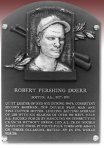
- Played 14 seasons in Majors, all with Red Sox (1937-44, 1946-51), before retiring due to a back injury.
- Elected to Baseball Hall of Fame in 1986.
- Tied for AL lead with Dom DiMaggio in triples in 1950 (11).
- Led AL in slugging percentage in 1944 (.528).
- Named The Sporting News AL Player of the Year in 1944.
- Hit .409 (9-22) in 1946 World Series to lead Red Sox.
Joe Cronin – #4
- First modern-day player to become a league president.
- Elected to Baseball Hall of Fame in 1956.
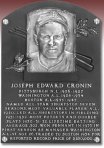
- Compiled .301 average in 20 MLB seasons.
- Affiliated with Red Sox for 24 seasons as player/manager, manager, and general manager.
- Leads all Red Sox managers with 1071 wins.
- Managed Red Sox to AL pennant in 1946.
- Holds AL record for pinch-hit homers in a season, 5 (1943).
- Became 1st player to hit pinch-hit homes in both games of a doubleheader, June 17, 1943 (in a stretch when he hit three three-run pinch-hit homers in four at-bats).
- Participated in 12 All-Star Games for AL, six as a player.
Johnny Pesky – #6
- Signed by the Red Sox in 1940.
- Officially associated with the Red Sox for 21 years as a player, coach, and manager.
- Compiled .307 average in 12 MLB seasons.
- Known as “Mr. Red Sox”.
Carl Yastrzemski – #8
- Named to the Baseball Hall of Fame in 1989.
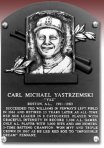
- Along with Johnny Bench became the 18th and 19th players elected to Hall of Fame on the first ballot.
- Received 95 percent of Hall of Fame voting, the seventh highest in the history of voting at that time.
- First Little League player to be elected to the Hall of Fame.
- Won AL Triple Crown in 1967.
- Most games lifetime in the AL with 3,308.
- AL MVP in 1967.
- Seven-time Gold Glove winner.
- Tied MLB record with 1.000 fielding percentage in 1977.
- Selected Outstanding Player of 1970 All-Star Game.
- Played 167 consecutive errorless games.
- Only AL player with 400 home runs and 3,000 hits.
Ted Williams – #9
- Named to starting outfield of Greatest Living Team, 1969.
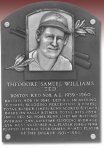
- Named MLB Player of Decade for 1950s.
- Elected to Baseball Hall of Fame in 1966.
- AL MVP in 1946, 49.
- Won AL Triple Crown in 1942, 47.
- Led AL in batting six times.
- Led AL in home runs four times.
- Led AL in total bases five times.
- Led AL in walks eight times.
- Led AL in slugging percentage nine times.
- Holds MLB record for most successive times reaching base safely, 16, in Sept. 1957 (2 singles, 4 HR, 9 BB, 1 HBP).
- Oldest MLB player to win batting title, batting .388 in 1957 at age 39.
- Won batting title again in 1958 at age 40.
- Voted Greatest Red Sox Player of all time by fans, 1969 and 1982.
- Holds MLB rookie records for most walks (107) and RBIs (145).
- Holds Red Sox record with 17 grand slams.
Jim Rice – #14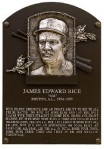
- Debuted August 19, 1974.
- Named AL Silver Slugger in 1984 and 1985.
- Named AL MVP in 1978.
- Named to eight All-Star teams.
- Led AL with hits (213) in 1978.
- Led AL in home runs in 1977 (39), 1978 (46), and 1983 (39).
- Elected to Baseball Hall of Fame in 2009.
Carlton Fisk – #27
- Carlton Fisk will always be remembered as the player who hit the historic, 12th-inning, game-winning homer in
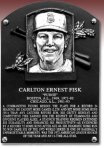 Fenway Park off Reds pitcher Pat Darcy in Game 6 of the 1975 World Series. Besides being the hero on MLB’s biggest stage in a game that has been referred to as “the greatest World Series game ever played,” Fisk had many other memorable highlights during his 11-year career as a member of the Red Sox.
Fenway Park off Reds pitcher Pat Darcy in Game 6 of the 1975 World Series. Besides being the hero on MLB’s biggest stage in a game that has been referred to as “the greatest World Series game ever played,” Fisk had many other memorable highlights during his 11-year career as a member of the Red Sox. - Red Sox first draft choice and fourth overall selection in the January 1967 Winter Baseball Amateur Draft.
- Made his MLB debut on September 18, 1969.
- Was the first unanimous winner of the American League Rookie of the Year Award in 1972 (.293, 22 HR, 61 RBIs). He was also tied for the AL lead with nine triples.
- Won the 1972 AL Gold Glove Award for defensive excellence.
- Seven-time All-Star, including four games started. He was voted as a starter five times but was replaced in 1974 due to a knee injury.
- Was the AL Honorary All-Star Game captain on July 13, 1999 at Fenway Park.
- Is the all-time Red Sox leader in games caught with 990.
- Red Sox Hall of Fame Inductee on September 8, 1997.
Now obviously, Johnny Pesky is the only member of Retired Row who is not a member of the Hall but was retired due to his decades of service to the Olde Towne Team… and rightfully so, however that does leave the ‘door open’ so to speak for other players and a whole sh!tload of “Why not him..”, “He should be..” so on and so forth. And with a few of the omitted Hall of Famer’s not on Retired Row, they may just have a case…. but I’ve covered this very argument in earlier editions of this same blog and this particular entry is not for that reason….
So let’s recap. The Boston Red Sox Hall of Fame. The All-Time Red Sox leaders in statistics. The National Baseball Hall of Fame. Retired Row.
The basics are set.
Ted and Yaz were the only real givens.
Now we get to the difficult part. Who gets added to the list and where do they get placed? Should it be a ‘Top 5’ or a ‘Top 10’? Aside from a minimum number of at bats or appearances, what qualifications should allow for a player to be named ‘Top’ or ‘Best of’ for the Red Sox? Championships are certainly out the door otherwise we’d have to disqualify one of the Greatest Players to Never Win a Title in Williams, and that renders pennants useless as well. If we go just on statistics, it may give an advantage to players who climbed the numbers ladder due to longevity and not superb ability.. but if they didn’t have the ability, one would think they never would have had the longevity.
Rice. Clemens. Evans. The Million Dollar Outfield of Speaker, Hooper and Lewis. Ortiz. Ruth. Vaughn. The Teammates of DiMaggio, Pesky and Doerr. Lynn. Pedroia. Collins. Schilling. Young. Foxx. Tiant. Garciaparra. Varitek. Boggs. Wakefield. Cronin. Grove. Youkilis. Fisk… to name a few.
Decisions, decisions.
The Red Sox Hall of Fame…
With questions of ‘The Best’ or ‘Top 5’, ‘Top 10’ and so on I figured I’d take a moment to look over the hallowed halls of the Boston Red Sox Hall of Fame.
These are the basics…
The Boston Red Sox Hall of Fame was instituted in 1995 to recognize the careers of former Boston Red Sox baseball players. A 15-member selection committee of Red Sox broadcasters and executives, past and present media personnel, and representatives from The Sports Museum of New England and the BoSox Club are responsible for nominating candidates.
The criteria for selection into the Hall is as follows:
- Player to be eligible for nomination must have played a minimum of three years with the Boston Red Sox and must also have been out of uniform as an active player a minimum of three years.
- Non-uniformed honorees such as broadcasters and front office execs are inducted by a unanimous vote of the Boston Red Sox Hall of Fame selection committee. The memorable moment will be chosen by the committee as well.
- Former Boston Red Sox players and personnel in the National Baseball Hall of Fame (NBHOF) in Cooperstown, New York will be automatically enshrined in the Boston Red Sox Hall of Fame.
|
|
Memorable moments
- 1995: Roger Clemens’ first 20-strikeout game in 1986
- 1995: Carlton Fisk’s game-winning home run in Game 6 of the 1975 World Series
- 2000: Dave Henderson’s game-winning home run in Game 5 of the 1986 American League Championship Series
- 2002: Earl Wilson’s no-hitter on June 26, 1962
- 2004: Bernie Carbo’s pinch-hit home run in Game 6 of the 1975 World Series
- 2006: Dave Roberts’ steal of second base in Game 4 of the 2004 American League Championship Series
- 2008: Ted Williams’ home run in his final Major League at-bat on September 28, 1960, versus the Baltimore Orioles at Fenway Park
- 2010: Tom Brunansky’s diving catch of Ozzie Guillén’s line drive in the ninth inning of the season ending game that preserved the Red Sox victory sending them to the 1990 playoffs
And all of this information, sadly, still doesn’t lend itself to the easy selection of ‘Top Something Red Sox of all-time’. So I guess we’ll have to do it the hard way and look at the facts, stat for stat, player by player… oh boy. Now, to weave through the enormous bulk of the statistics and the lesser players who exist in the higher end of all-time numbers through the merit of less time served, I’m planning on setting a minimum of 800 games played in a Red Sox uniform.
Batting Average: Home Runs:
1. Ted Williams .344 Ted Williams 521
2. Wade Boggs .338 C. Yastrzemski 452
3. Tris Speaker .337 Jim Rice 382
4. N. Garciaparra .323 Dwight Evans 379
5. Jimmie Foxx .320 David Ortiz* 310
6. Johnny Pesky .313 Manny Ramirez 274
7. Manny Ramirez .312 Mo Vaughn 230
8. Fred Lynn .308 Bobby Doerr 223
9. Billy Goodman .306 Jimmie Foxx 222
10. Mo Vaughn .304 Rico Petrocelli 210
Runs Batted In: Games:
C. Yastrzemski 1844 C. Yastrzemski 3308
Ted Williams 1839 Dwight Evans 2505
Jim Rice 1451 Ted Williams 2292
Dwight Evans 1346 Jim Rice 2089
Bobby Doerr 1247 Bobby Doerr 1865
David Ortiz* 987 Harry Hooper 1647
Manny Ramirez 868 Wade Boggs 1625
Jimmie Foxx 788 Rico Petrocelli 1553
Rico Petrocelli 773 Jason Varitek* 1520
Mo Vaughn 752 Dom DiMaggio 1399
Doubles: Triples:
1. C. Yastrzemski 646 Harry Hooper 130
2. Ted Williams 525 Tris Speaker 106
3. Dwight Evans 474 Buck Freeman 90
4. Wade Boggs 422 Bobby Doerr 89
5. Bobby Doerr 381 Larry Gardner 87
6. Jim Rice 373 Jim Rice 79
7. David Ortiz* 331 ‘Hobe’ Ferris 77
8. Dom DiMaggio 308 Dwight Evans 72
9. Jason Varitek* 305 Ted Williams 71
10. N. Garciaparra 279 Freddy Parent 63
Bases on Balls: Runs Scored:
Ted Williams 2019 C. Yastrzemski 1816
C. Yastrzemski 1845 Ted Williams 1798
Dwight Evans 1337 Dwight Evans 1435
Harry Hooper 826 Bobby Doerr 1094
Bobby Doerr 809 Wade Boggs 1067
Dom DiMaggio 750 Dom DiMaggio 1046
David Ortiz* 734 Harry Hooper 988
Jim Rice 670 David Ortiz* 812
Rico Petrocelli 661 Johnny Pesky 776
For the same reason of wading through the massive amount of statistics, I limited my selections of pitchers to a minimum 200 appearances in a Red Sox uniform.
Wins: Earned Run Average:
1. Roger Clemens 192 Joe Wood 1.99
2. Cy Young 192 Cy Young 2.00
3. Tim Wakefield* 184 Dutch Leonard 2.13
4. Mel Parnell 123 Pedro Martinez 2.52
5. Luis Tiant 122 George Winter 2.91
6. Pedro Martinez 117 Tex Huson 2.94
7. Joe Wood 117 Roger Clemens 3.06
8. Bob Stanley 115 Ellis Kinder 3.28
9. Joe Dobson 106 Lefty Grove 3.34
10. Lefty Grove 105 Luis Tiant 3.36
Strikeouts: Complete Games:
Roger Clemens 2590 Cy Young 275
Tim Wakefield* 1993 George Winter 141
Pedro Martinez 1683 Joe Wood 121
Cy Young 1341 Lefty Grove 119
Luis Tiant 1075 Mel Parnell 113
Bruce Hurst 1043 Luis Tiant 113
Joe Wood 986 Roger Clemens 100
B. Monbouquette 969 Tex Huson 99
Frank Sullivan 821 Dutch Leonard 96
Jim Lonborg 784 Joe Dobson 90
Innings Pitched: Shutouts:
1. Tim Wakefield* 2933.0 Roger Clemens 38
2. Roger Clemens 2776.0 Cy Young 38
3. Cy Young 2728.1 Joe Wood 28
4. Luis Tiant 1774.2 Luis Tiant 26
5. Mel Parnell 1752.2 Dutch Leonard 25
6. Bob Stanley 1707.0 Mel Parnell 20
7. B. Monbouquette 1622.0 Tex Huson 19
8. George Winter 1599.2 Joe Dobson 17
9. Joe Dobson 1544.0 B. Monbouquette 16
10. Lefty Grove 1539.2 Lefty Grove 15
Saves have been included simply for historical significance. I’m listing the full top ten, but lowering the minimum to 100 appearances in a Red Sox uniform.
Saves:
1. Jon Papelbon* 208
2. Bob Stanley 132
3. Dick Radatz 104
4. Ellis Kinder 91
5. Jeff Reardon 88
6. Derek Lowe* 85
7. Sparky Lyle 69
8. Tom Gordon 68
9. Lee Smith 58
10. Bill Campbell 51
Now a lot of names repeat themselves in these lists of all-time stats, while a few names were omitted for lack of appearances, such as Pete Runnels for a few hitting categories and pitchers Jon Lester and Josh Beckett for strikeouts as well as Babe Ruth for a number of pitching categories including ERA (4th with 2.19), complete games (8th with 105) and shutouts (11th with 17). I left out stats such as Extra Base Hits, Slugging and On-Base percentages as they were simply more of the same names in different order. You can view them yourself here: http://boston.redsox.mlb.com/bos/history/all_time_leaders.jsp
Okay, there are the stats for the most part (no, I’m not including fielding stats because a few of the categories are geared towards infielders, particularly first basemen and catchers), so lets take a look at award winners.
Most Valuable Player: This is the BBWAA MVP award created in 1931, and does not include the Chalmers Award (1911–1914) or the League Awards (1922–1929).
Dustin Pedroia* (2008), Mo Vaughn (1995), Roger Clemens (1986), Jim Rice (1978), Fred Lynn (1975), Yaz (1967), Jackie Jensen (1958), Ted Williams (1949 & 1946) and Jimmie Foxx (1938).
Rookie of the Year:
Dustin Pedroia (2007), Nomar Garciaparra (1997), Fred Lynn (1975), Carlton Fisk (1972), Don Schwall (1961) and Walt Dropo (1950).
Now lets take a look at a few more historical league leaders…
… We’ll cover hitting first…
| Batting Champions | ||
| Year | Player | Average |
| 2003 | Bill Mueller | .326 |
| 2002 | Manny Ramirez | .349 |
| 2000 | Nomar Garciaparra | .372 |
| 1999 | Nomar Garciaparra | .357 |
| 1988 | Wade Boggs | .366 |
| 1987 | Wade Boggs | .363 |
| 1986 | Wade Boggs | .357 |
| 1985 | Wade Boggs | .368 |
| 1983 | Wade Boggs | .361 |
| 1981 | Carney Lansford | .336 |
| 1979 | Fred Lynn | .333 |
| 1968 | Carl Yastrzemski | .301 |
| 1967 | Carl Yastrzemski | .326 |
| 1963 | Carl Yastrzemski | .321 |
| 1962 | Pete Runnels | .326 |
| 1960 | Pete Runnels | .320 |
| 1958 | Ted Williams | .328 |
| 1957 | Ted Williams | .388 |
| 1950 | Billy Goodman | .354 |
| 1948 | Ted Williams | .369 |
| 1947 | Ted Williams | .343 |
| 1942 | Ted Williams | .356 |
| 1941 | Ted Williams | .406 |
| 1938 | Jimmie Foxx | .349 |
| 1932 | Dale Alexander | .367 |
| Home Run Champions | ||
| Year | Player | HR |
| 1984 | Tony Armas | 43 |
| 1983 | Jim Rice | 39 |
| 1981 | Dwight Evans | 22 |
| 1978 | Jim Rice | 46 |
| 1977 | Jim Rice | 39 |
| 1967 | Carl Yastrzemski | 44 |
| 1965 | Tony Conigliaro | 32 |
| 1949 | Ted Williams | 43 |
| 1947 | Ted Williams | 32 |
| 1942 | Ted Williams | 36 |
| 1941 | Ted Williams | 37 |
| 1939 | Jimmie Foxx | 35 |
| 1919 | Babe Ruth | 29 |
| 1918 | Babe Ruth | 11 |
| 1912 | Tris Speaker | 10 |
| 1910 | Jake Stahl | 10 |
| 1903 | Buck Freeman | 13 |
| Triple Crown: Batting | ||
| Year | Player | Avg., HR, RBIs |
| 1967 | Carl Yastrzemski | .326, 44, 121 |
| 1947 | Ted Williams | .343, 32, 114 |
| 1942 | Ted Williams | .356, 36, 137 |
… And now the Pitching…
| ERA Champions | ||
| Year | Player | ERA |
| 2003 | Pedro Martinez | 2.22 |
| 2002 | Pedro Martinez | 2.26 |
| 2000 | Pedro Martinez | 1.74 |
| 1999 | Pedro Martinez | 2.07 |
| 1992 | Roger Clemens | 2.41 |
| 1991 | Roger Clemens | 2.62 |
| 1990 | Roger Clemens | 1.93 |
| 1986 | Roger Clemens | 2.48 |
| 1972 | Luis Tiant | 1.91 |
| 1949 | Mel Parnell | 2.78 |
| 1939 | Lefty Grove | 2.54 |
| 1938 | Lefty Grove | 3.08 |
| 1936 | Lefty Grove | 2.81 |
| 1935 | Lefty Grove | 2.70 |
| 1916 | Babe Ruth | 1.75 |
| 1915 | Joe Wood | 1.49 |
| 1914 | Dutch Leonard | 0.96 |
| 1901 | Cy Young | 1.62 |
| Strikeout Champions | ||
| Year | Player | Strikeouts |
| 2002 | Pedro Martinez | 239 |
| 2001 | Hideo Nomo | 220 |
| 2000 | Pedro Martinez | 284 |
| 1999 | Pedro Martinez | 313 |
| 1996 | Roger Clemens | 257 |
| 1991 | Roger Clemens | 241 |
| 1988 | Roger Clemens | 291 |
| 1967 | Jim Lonborg | 246 |
| 1942 | Tex Hughson | 113 |
| 1901 | Cy Young | 158 |
| Triple Crown: Pitching | ||
| Year | Player | Wins, ERA, Ks |
| 1999 | Pedro Martinez | 23, 2.07, 313 |
| 1901 | Cy Young | 33, 1.62, 158 |
| Cy Young | |
| Pedro Martinez | 2000 |
| Pedro Martinez | 1999 |
| Roger Clemens | 1991 |
| Roger Clemens | 1987 |
| Roger Clemens | 1986 |
| Jim Lonborg | 1967 |
Now, for the sake of being fairly thorough and not wanting to completely leave the legendary defensive efforts in limbo, here are the list of Gold Glove Winners…
| Gold Gloves | ||
| Player | Pos | Year |
| Dustin Pedroia | 2B | 2008 |
| Jason Varitek | C | 2005 |
| Tony Peña | C | 1991 |
| Ellis Burks | OF | 1990 |
| Dwight Evans | OF | 1985 |
| Dwight Evans | OF | 1984 |
| Dwight Evans | OF | 1983 |
| Dwight Evans | OF | 1982 |
| Dwight Evans | OF | 1981 |
| Fred Lynn | OF | 1980 |
| Fred Lynn | OF | 1979 |
| Dwight Evans | OF | 1979 |
| Rick Burleson | SS | 1979 |
| Fred Lynn | OF | 1978 |
| Dwight Evans | OF | 1978 |
| Carl Yastrzemski | OF | 1977 |
| Dwight Evans | OF | 1976 |
| Fred Lynn | OF | 1975 |
| Doug Griffin | 2B | 1972 |
| Carlton Fisk | C | 1972 |
| Carl Yastrzemski | OF | 1971 |
| George Scott | 1B | 1971 |
| Carl Yastrzemski | OF | 1969 |
| Reggie Smith | OF | 1968 |
| Carl Yastrzemski | OF | 1968 |
| George Scott | 1B | 1968 |
| Carl Yastrzemski | OF | 1967 |
| George Scott | 1B | 1967 |
| Carl Yastrzemski | OF | 1965 |
| Carl Yastrzemski | OF | 1963 |
| Jackie Jensen | OF | 1959 |
| Frank Malzone | 3B | 1959 |
| Jim Piersall | CF | 1958 |
| Frank Malzone | 3B | 1958 |
| Frank Malzone | 3B | 1957 |
So, has any of this cemented anything? No… but it has provided a little bit more depth into the varied history of the players who have worn the Red, White and Blue of the Boston Americans across the many decades. Looking at a few of these league leading categories, it also sheds some light on periods where offense seemed to overshadow pitching and how both seemed to dwarf defense… but then again, the Yawkey regime was always known for the sizzle of the home run show over the actual steak of baseball.
Okay, for the next installment I’ll be looking at those who are inductees into the National Baseball Hall of Fame and probably a few players who should have been but weren’t. Hey, you can’t make an omelete without breaking some eggs and sure as hell can’t have any sort of ‘Best of…’ or ‘Top (insert number here)..’ list without a little controversy.
A Brief History…
With all this talk of Retired numbers, Honored numbers and such… how about a brief lesson on the history of baseball’s uniforms with a thanks to Wikipedia.
A baseball uniform is a type of uniform worn by baseball players, and by some non-playing personnel, such as field managers and coaches. It is worn to indicate the person’s role in the game and — through the use of logos, colors, and numbers — to identify the teams and their players, managers, and coaches.
The New York Knickerbockers were the first baseball team to use uniforms, taking the field on April 4, 1849, in pants made of blue wool, white flannel shirts (jerseys) and straw hats. The practice of wearing a uniform soon spread, and by 1900, all major league teams had adopted them. By 1882, most uniforms included stockings, which covered the leg from foot to knee, and had different colors that reflected the different baseball positions. In the late 1880s, the Detroit Wolverines and Washington Nationals of the National League and the Brooklyn Bridegrooms of the American Association were the first to wear striped uniforms.
Caps, or other types of headgear with eyeshades, have been a part of baseball uniforms from the beginning. Baseball teams often wore full-brimmed straw hats or no cap at all since there was no official rule regarding headgear. Completing the baseball uniform are cleats and stockings, both of which have also been around for a long time.
By the end of the 19th century, teams began the practice of having two different uniforms, one for when they played at home in their own baseball stadium and a different one for when they played away (on the road) at the other tea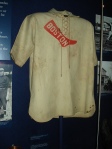 m’s ballpark. It became common to wear white pants with a white color vest at home and gray pants with a gray or solid color vest when away. Most modern teams also have one or more alternate uniforms, usually consisting of the primary or secondary team color on the vest instead of the usual white or gray. Teams on occasion will also wear throwback uniforms.
m’s ballpark. It became common to wear white pants with a white color vest at home and gray pants with a gray or solid color vest when away. Most modern teams also have one or more alternate uniforms, usually consisting of the primary or secondary team color on the vest instead of the usual white or gray. Teams on occasion will also wear throwback uniforms.
Traditionally home uniforms have displayed the team name on the front, while away uniforms have displayed the name of the city (or state) that the team is from. There are many exceptions to that rule, however.
The earliest photographic evidence of the use of uniform numbers comes from a 1909 Chicago Daily News picture of pitching great José Mendez. In the photograph, Mendez is seen in his Cuban Stars uniform with a number “12” on his left sleeve. Inspired by hockey’s and football’s use of uniform numbers, the Cleveland Indians became the first big league club to experiment with numbered uniforms when they took the field at League Park in Cleveland, on June 26, 1916, donning large numerals on their left sleeves. The experiment lasted just a few weeks that season and, after a brief trial the following year, was abandoned altogether.
The first MLB game to have both teams wear numbers on their jerseys was Indians vs Yankees May 13, 1929.
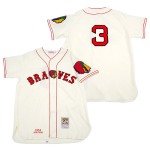 While some players will wear several numbers throughout their careers as they move from team to team, others have become so attached to a specific number for some reason (including superstition), that try to acquire it as they join a new club.
While some players will wear several numbers throughout their careers as they move from team to team, others have become so attached to a specific number for some reason (including superstition), that try to acquire it as they join a new club.
In some cases, the number is available on a player’s new club. Other times, the number will already be in use by another member of that team (or sometimes retired). When this occurs, the player will occasionally ask the other player to change numbers, in order to surrender that number to the newcomer. Some players holding a number in such a case will voluntarily make such a change, while others may need to be “bribed” in order to do so. For example, when Rickey Henderson was traded to the Blue Jays in 1993, he paid new teammate Turner Ward $25,000 for the #24 that Henderson had worn throughout much of his career, and that Ward had been wearing at the time. In contrast, when Mitch Williams joined the Phillies in 1991, he acquired his old #28 from John Kruk in exchange for $10 and two cases of beer.
Some players, who are unable to get the number they had on their previous team, will obtain a number close in succession. For example, Roger Clemens wore #21 during the first 15 years of his career with the Red Sox and Blue Jays, and during his college days at Texas. Upon Clemens’ arrival in New York, he reportedly asked long-time Yankee outfielder Paul O’Neill to surrender his #21, but O’Neill refused. Though he would eventually opt for #22, Clemens initially reversed his beloved #21, and wore #12. Clemens continued to wear #22 upon signing with his hometown Houston Astros in 2004 and, upon resigning with the Yankees, Robinson Canó, owner of #22 at the beginning of the 2007 season, moved to #24 in anticipation of the Yankees possibly re-signing Clemens, leaving #22 available for Clemens.
in succession. For example, Roger Clemens wore #21 during the first 15 years of his career with the Red Sox and Blue Jays, and during his college days at Texas. Upon Clemens’ arrival in New York, he reportedly asked long-time Yankee outfielder Paul O’Neill to surrender his #21, but O’Neill refused. Though he would eventually opt for #22, Clemens initially reversed his beloved #21, and wore #12. Clemens continued to wear #22 upon signing with his hometown Houston Astros in 2004 and, upon resigning with the Yankees, Robinson Canó, owner of #22 at the beginning of the 2007 season, moved to #24 in anticipation of the Yankees possibly re-signing Clemens, leaving #22 available for Clemens.
In their first career games, Cincinnati Reds outfielder Eric Davis and White Sox pitcher Joe Horlen did not have jersey numbers.
Detroit Tigers center fielder Gabe Kapler also played a game with a blank jersey, though it that case the Tigers were playing the final game at Tiger Stadium and the players were honoring the famous Tigers in each position. In Kapler’s case he was honoring Ty Cobb, whose career pre-dated uniform numbers.
 A team will sometimes retire a uniform number so that future players and coaches cannot wear those numbers with that team. Only the player with the retired number can wear that number if he returns to that team as a player or coach. The first Major League Baseball player to have his number retired was Lou Gehrig (#4). #4 and #5 have each been retired by 8 teams, more than any other number. The Yankees have retired a total of 16 numbers, more than any other team. The highest player uniform number to be retired was Carlton Fisk’s #72, but the Cardinals retired #85 in honor of their one-time owner August Busch, Jr.. Though he never wore a unifor
A team will sometimes retire a uniform number so that future players and coaches cannot wear those numbers with that team. Only the player with the retired number can wear that number if he returns to that team as a player or coach. The first Major League Baseball player to have his number retired was Lou Gehrig (#4). #4 and #5 have each been retired by 8 teams, more than any other number. The Yankees have retired a total of 16 numbers, more than any other team. The highest player uniform number to be retired was Carlton Fisk’s #72, but the Cardinals retired #85 in honor of their one-time owner August Busch, Jr.. Though he never wore a unifor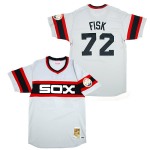 m, that is how old he was at the time of the honor. The Cleveland Indians retired the #455 in 2001 in honor of “the fans”, to commemorate the then-longest home sellout streak ever (although MLB does not allow any team to issue three-digit uniform numbers).
m, that is how old he was at the time of the honor. The Cleveland Indians retired the #455 in 2001 in honor of “the fans”, to commemorate the then-longest home sellout streak ever (although MLB does not allow any team to issue three-digit uniform numbers).
Eight players and one manager, Casey Stengel, have had their numbers retired with more than one team. Nolan Ryan had two different numbers (#30 and #34) retired between three different teams. Fisk’s #27 from the Red Sox and #72 from the White Sox are both retired, as are Reggie Jackson’s #9 and #44, respectively by the A’s and Yankees.
The Toronto Blue Jays do not retire numbers, but rather have an alternative method of honoring their players called the ‘Level of Excellence’.
 In 1997, Major League Baseball, for the first time ever, made a Major League-wide retirement of a number, when #42 could not be issued to any new players, having been retired in honor of Jackie Robinson, although all players who currently wore the number upon the mass retirement of #42, such as Mo Vaughn and Butch Huskey of the Red Sox and Mets, were allowed to keep it under a grandfather clause if they were wearing the number in honor of Jackie Robinson. The only player who still wears #42 is Mariano Rivera of the New York Yankees. The Los Angeles Dodgers, for whom Robinson played (as a Brooklyn Dodger), had already retired the number in 1972 after Robinson’s death.
In 1997, Major League Baseball, for the first time ever, made a Major League-wide retirement of a number, when #42 could not be issued to any new players, having been retired in honor of Jackie Robinson, although all players who currently wore the number upon the mass retirement of #42, such as Mo Vaughn and Butch Huskey of the Red Sox and Mets, were allowed to keep it under a grandfather clause if they were wearing the number in honor of Jackie Robinson. The only player who still wears #42 is Mariano Rivera of the New York Yankees. The Los Angeles Dodgers, for whom Robinson played (as a Brooklyn Dodger), had already retired the number in 1972 after Robinson’s death.
However, the #42 would be worn by a number of players other than Rivera in 2007, which marked the 60th anniversary of Robinson’s first appearance in Major League Baseball (the event that broke the sport’s 20th-century color line). Before the season, then-Cincinnati Reds outfielder Ken Griffey, Jr. asked Robinson’s widow, Rachel Robinson, and MLB Commissioner Bud Selig for permission to wear #42 on April 15, the anniversary date of Robinson’s historic game. Both gave their approval, and Selig later ruled that any player who wished to wear #42 on that date could do so.
Honored Numbers… honorable mention…
A few more former members of the Boston Americans who made an impact while in Scarlett Hose for consideration. Again, they’re members of the Red Sox Hall of Fame and on the Bubble.
And yes, there just might be yet another controversial pick….
 Bill Lee, nicknamed “Spaceman”, played for the Boston Red Sox from 1969-1978 and on November 7, 2008, Lee was inducted into the Red Sox Hall of Fame as the team’s record-holder for most games pitched by a left-hander (321) and the third-highest win total (94) by a Red Sox southpaw. In addition to his baseball experience, Lee is known for his adherence to counterculture behavior, his antics both on and off the field, and his use of the Leephus pitch, a personalized variation of the eephus pitch. Lacking a good fastball, Lee developed off-speed pitches, including a variation of the Eephus pitch. The Leephus pitch or Space Ball, the names for Lee’s take on the eephus pitch, follows a high, arcing trajectory and is very slow. Lee was used almost exclusively as a relief pitcher during the first four years of his career. During that period, Lee appeared in 125 games, starting in nine, and compiled a 19-11 record. In 1973, he was used primarily as a starting pitcher. He started 33 of the 38 games in which he appeared and went 17-11 with a 2.95 Earned Run Average, and was named to the American League All-Star team. He followed 1973 with two more 17-win seasons. He started two games in the 1975 World Series against the Cincinnati Reds. His first start came in Game 2 of the series which the Reds won 3-2. In Game 7, Lee shut out the Reds for five innings and the Red Sox took a 3-0 lead. Lee left with a blister and the Red Sox lost the game by a score of 4-3, and the 1975 World Series four games to three. During the 1978 season, Lee and Red Sox manager Don Zimmer engaged in an ongoing public feud over the handling of the pitching staff. Lee’s countercultural attitude and lack of respect for authority clashed with Zimmer’s old-school, conservative personality. Lee and a few other of the more anti-authority Red Sox formed what they called “The Buffalo Heads” as a response to the manager. Zimmer retaliated during the season by relegating Lee to the bullpen and convincing management to trade away some of them, including Hall of Famer Fergie Jenkins and Bernie Carbo. Jersey #37
Bill Lee, nicknamed “Spaceman”, played for the Boston Red Sox from 1969-1978 and on November 7, 2008, Lee was inducted into the Red Sox Hall of Fame as the team’s record-holder for most games pitched by a left-hander (321) and the third-highest win total (94) by a Red Sox southpaw. In addition to his baseball experience, Lee is known for his adherence to counterculture behavior, his antics both on and off the field, and his use of the Leephus pitch, a personalized variation of the eephus pitch. Lacking a good fastball, Lee developed off-speed pitches, including a variation of the Eephus pitch. The Leephus pitch or Space Ball, the names for Lee’s take on the eephus pitch, follows a high, arcing trajectory and is very slow. Lee was used almost exclusively as a relief pitcher during the first four years of his career. During that period, Lee appeared in 125 games, starting in nine, and compiled a 19-11 record. In 1973, he was used primarily as a starting pitcher. He started 33 of the 38 games in which he appeared and went 17-11 with a 2.95 Earned Run Average, and was named to the American League All-Star team. He followed 1973 with two more 17-win seasons. He started two games in the 1975 World Series against the Cincinnati Reds. His first start came in Game 2 of the series which the Reds won 3-2. In Game 7, Lee shut out the Reds for five innings and the Red Sox took a 3-0 lead. Lee left with a blister and the Red Sox lost the game by a score of 4-3, and the 1975 World Series four games to three. During the 1978 season, Lee and Red Sox manager Don Zimmer engaged in an ongoing public feud over the handling of the pitching staff. Lee’s countercultural attitude and lack of respect for authority clashed with Zimmer’s old-school, conservative personality. Lee and a few other of the more anti-authority Red Sox formed what they called “The Buffalo Heads” as a response to the manager. Zimmer retaliated during the season by relegating Lee to the bullpen and convincing management to trade away some of them, including Hall of Famer Fergie Jenkins and Bernie Carbo. Jersey #37
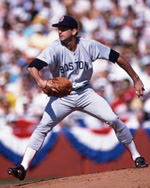 Bruce Hurst and Roger Clemens will forever be remembered as one of the best one-two punches in the Red Sox history. Hurst was a specialist at changing speeds. Consistently good but never overpowering hitters, his fastball was hard enough to get in on right-handed hitters, and he mixed it with an excellent curve and a slider as well. He also had a decent forkball at times. Thanks to his great control, Hurst was able to work corners well and had a profuse knowledge of each hitter. He won 88 games for the Red Sox in a span of nine years, posting his best season in 1988 with an 18-6 record. In 1986, despite spending six midsummer weeks on the disabled list with a pulled groin, Hurst posted a 2.99 ERA with 13 victories and helped lead the Red Sox to the 1986 World Series against the New York Mets. He won Game 1 1-0 and Game 5 4-2 to give Boston a 3-2 lead in the Series. The score in Game 6 stood at 3-3 after nine innings. The Red Sox scored in the top of the tenth on a home run by Dave Henderson, then added an insurance run. With nobody on and two outs in the bottom of the tenth, the Shea Stadium scoreboard was all set to display “Congratulations Boston Red Sox, 1986 World Champions”, with Hurst being selected as the World Series Most Valuable Player. Suddenly, the Mets rallied to win the game with three runs, forcing decisive Game 7. With three days rest, Hurst had given up only three singles through six innings and left the game tied 3-3. The rest is history, with the Mets winning the World Championship. Believers of “The Curse of the Bambino” have pointed out the letters in the name BRUCE HURST can be re-arranged as B RUTH CURSE. Jersey #47
Bruce Hurst and Roger Clemens will forever be remembered as one of the best one-two punches in the Red Sox history. Hurst was a specialist at changing speeds. Consistently good but never overpowering hitters, his fastball was hard enough to get in on right-handed hitters, and he mixed it with an excellent curve and a slider as well. He also had a decent forkball at times. Thanks to his great control, Hurst was able to work corners well and had a profuse knowledge of each hitter. He won 88 games for the Red Sox in a span of nine years, posting his best season in 1988 with an 18-6 record. In 1986, despite spending six midsummer weeks on the disabled list with a pulled groin, Hurst posted a 2.99 ERA with 13 victories and helped lead the Red Sox to the 1986 World Series against the New York Mets. He won Game 1 1-0 and Game 5 4-2 to give Boston a 3-2 lead in the Series. The score in Game 6 stood at 3-3 after nine innings. The Red Sox scored in the top of the tenth on a home run by Dave Henderson, then added an insurance run. With nobody on and two outs in the bottom of the tenth, the Shea Stadium scoreboard was all set to display “Congratulations Boston Red Sox, 1986 World Champions”, with Hurst being selected as the World Series Most Valuable Player. Suddenly, the Mets rallied to win the game with three runs, forcing decisive Game 7. With three days rest, Hurst had given up only three singles through six innings and left the game tied 3-3. The rest is history, with the Mets winning the World Championship. Believers of “The Curse of the Bambino” have pointed out the letters in the name BRUCE HURST can be re-arranged as B RUTH CURSE. Jersey #47
Jerry Remy was traded to the Boston Red Sox after the 1977 season and continued as the Red Sox starter at second in 1978, being selected to play in the All-Star Game, in which he did not appear. He continued as their starting second basemen for the next six seasons, although he was often hampered by injuries. Bill James, in his Historical Abstract rated him as the 100th greatest second baseman of all time as of 2002. Since 1988, Remy has found success in broadcasting, working for the New England Sports Network (NESN), as the color commentator for all NESN Red Sox broadcasts. Since 2001, Remy has been teamed with play-by-play announcer Don Orsillo. NESN celebrated Jerry Remy Day on June 24, 2008, in honor of Remy’s 20 years of service for the network. He is currently serving as the first president of Red Sox Nation. Jerry Remy was inducted into the Boston Red Sox Hall of Fame in 2006. Jersey #2
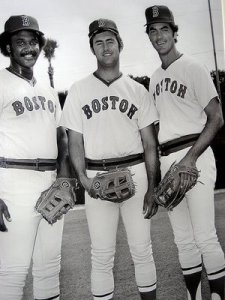 Fred Lynn, after graduation from USC, started his career for the Red Sox with a phenomenal 1975 season in which he won the Most Valuable Player and Rookie of the Year awards, the first player ever to win both in the same season. (The feat has since been duplicated by Seattle Mariners right fielder Ichiro Suzuki in 2001.) Lynn and fellow rookie outfielder Jim Rice were dubbed as the “Gold Dust Twins” because of their combined baseball talents. In 1975, Lynn led the American League in doubles, runs scored and slugging percentage, finished second in the batting race with a .331 average, and won a Gold Glove Award for his defensive play. On June 18 he bombed the Tigers with 3 HR, 10 RBI, and 16 total bases in one game. Unfortunately, Lynn found it difficult to duplicate the extraordinary success of his first season, and was hampered by injuries. These sometimes were caused by fearless play, such as a broken rib caused by crashing into an outfield wall, or knee injuries from breaking up double plays, but most were simply of the nagging variety, such as strains and sprains. Although he didn’t maintain the same level of his rookie season, he still excelled, winning three more Gold Gloves in 1978-80 and finishing 4th in the 1979 MVP voting, while being elected to the All-Star team every year with the Red Sox. Jersey #19.
Fred Lynn, after graduation from USC, started his career for the Red Sox with a phenomenal 1975 season in which he won the Most Valuable Player and Rookie of the Year awards, the first player ever to win both in the same season. (The feat has since been duplicated by Seattle Mariners right fielder Ichiro Suzuki in 2001.) Lynn and fellow rookie outfielder Jim Rice were dubbed as the “Gold Dust Twins” because of their combined baseball talents. In 1975, Lynn led the American League in doubles, runs scored and slugging percentage, finished second in the batting race with a .331 average, and won a Gold Glove Award for his defensive play. On June 18 he bombed the Tigers with 3 HR, 10 RBI, and 16 total bases in one game. Unfortunately, Lynn found it difficult to duplicate the extraordinary success of his first season, and was hampered by injuries. These sometimes were caused by fearless play, such as a broken rib caused by crashing into an outfield wall, or knee injuries from breaking up double plays, but most were simply of the nagging variety, such as strains and sprains. Although he didn’t maintain the same level of his rookie season, he still excelled, winning three more Gold Gloves in 1978-80 and finishing 4th in the 1979 MVP voting, while being elected to the All-Star team every year with the Red Sox. Jersey #19.
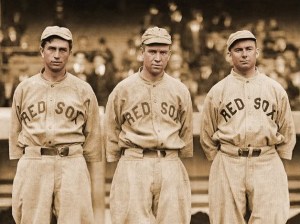 Harry Hooper, Tris Speaker and Duffy Lewis, nicknamed “The Million Dollar Outfield“. In 1910 the Red Sox signed Duffy Lewis, who became the left fielder, and, with Speaker and Harry Hooper would form Boston’s “Million-Dollar Outfield”, one of the finest outfield trios in baseball history, playing together until Speaker was traded to the Cleveland Indians in 1916. Harry Hooper, who batted left-handed and threw right-handed, broke into the majors with the Red Sox in 1909, and still holds many of the team’s records. He was traded to the Chicago White Sox in the 1921 season and finished his career in 1925. On May 30, 1913 Hooper became the first player to hit a home run to lead off both games of a doubleheader, a mark only matched by Rickey Henderson 80 years later. Beside this, Hooper is the only person to be a part of four Red Sox World Series championships: in 1912, 1915, 1916 and 1918. On October 13, 1915, he became the first player to hit two home runs in a single World Series game. Hooper was also the captain of the Red Sox in 1919. Tris Speaker, considered one of the best offensive and defensive center fielders in the history of Major League Baseball, compiled a career batting average of .345 (fourth all-time), and still holds the record of 792 career doubles. Defensively, his career records for assists, double plays, and unassisted double plays by an outfielder still stand as well. His fielding glove was known as the place “where triples go to die.” Speaker helped lead the Boston Red Sox to two World Series championships. As a manager (for Cleveland) his innovations, most notably the platoon system and the infield rotation play, revolutionized the game. He was inducted into the Baseball Hall of Fame in its second year of voting, 1937. Duffy Lewis won three World Series championships with the Red Sox (1912, 1915, 1916) and is considered perhaps one of the best ever in fielding skill. At bat, Lewis was a renowned line-drive hitter who consistently finished in the top ten in most offensive categories despite a short career which was interrupted by World War I.
Harry Hooper, Tris Speaker and Duffy Lewis, nicknamed “The Million Dollar Outfield“. In 1910 the Red Sox signed Duffy Lewis, who became the left fielder, and, with Speaker and Harry Hooper would form Boston’s “Million-Dollar Outfield”, one of the finest outfield trios in baseball history, playing together until Speaker was traded to the Cleveland Indians in 1916. Harry Hooper, who batted left-handed and threw right-handed, broke into the majors with the Red Sox in 1909, and still holds many of the team’s records. He was traded to the Chicago White Sox in the 1921 season and finished his career in 1925. On May 30, 1913 Hooper became the first player to hit a home run to lead off both games of a doubleheader, a mark only matched by Rickey Henderson 80 years later. Beside this, Hooper is the only person to be a part of four Red Sox World Series championships: in 1912, 1915, 1916 and 1918. On October 13, 1915, he became the first player to hit two home runs in a single World Series game. Hooper was also the captain of the Red Sox in 1919. Tris Speaker, considered one of the best offensive and defensive center fielders in the history of Major League Baseball, compiled a career batting average of .345 (fourth all-time), and still holds the record of 792 career doubles. Defensively, his career records for assists, double plays, and unassisted double plays by an outfielder still stand as well. His fielding glove was known as the place “where triples go to die.” Speaker helped lead the Boston Red Sox to two World Series championships. As a manager (for Cleveland) his innovations, most notably the platoon system and the infield rotation play, revolutionized the game. He was inducted into the Baseball Hall of Fame in its second year of voting, 1937. Duffy Lewis won three World Series championships with the Red Sox (1912, 1915, 1916) and is considered perhaps one of the best ever in fielding skill. At bat, Lewis was a renowned line-drive hitter who consistently finished in the top ten in most offensive categories despite a short career which was interrupted by World War I.
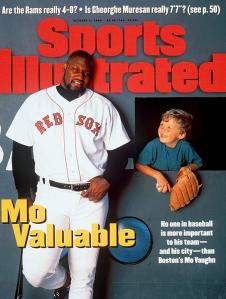 Mo Vaughn became the center of the Red Sox’s line-up in 1993, hitting 29 home runs and contributing 101 RBIs. In 1995, he established a reputation as one of the most feared hitters in the American League when he hit 39 home runs with 126 RBIs and a .300 average. He also garnered 11 stolen bases. His efforts, which led the Red Sox to the playoffs (only to lose to the Cleveland Indians in the American League Division Series), were rewarded with the American League MVP award. Vaughn had his career year with the Red Sox in 1996, batting an average of .326, playing in 161 games, with 44 home runs, and 143 RBIs. On May 30, 1997 playing a game against the Yankees, Vaughn went 4-for-4 with three solo homers in the Red Sox’s 10-4 win over the Yankees. Vaughn continued to improve over the next several seasons, batting .315 or higher from 1996 to 1998 and averaging 40 home runs and 118 RBIs. The Red Sox lost in the American League Division Series in 1998, once again to the Cleveland Indians, although Vaughn played well, hitting two home runs and driving in seven runs in game one. Vaughn formed a formidable middle of the lineup with shortstop Nomar Garciaparra. The two combined for 75 home runs in 1998, Vaughn’s final year with the club. He was noted for “crowding the plate”; his stance was such that his front elbow often appeared to be hovering in the strike zone, which intimidated pitchers into throwing wide and outside. Jersey # 42
Mo Vaughn became the center of the Red Sox’s line-up in 1993, hitting 29 home runs and contributing 101 RBIs. In 1995, he established a reputation as one of the most feared hitters in the American League when he hit 39 home runs with 126 RBIs and a .300 average. He also garnered 11 stolen bases. His efforts, which led the Red Sox to the playoffs (only to lose to the Cleveland Indians in the American League Division Series), were rewarded with the American League MVP award. Vaughn had his career year with the Red Sox in 1996, batting an average of .326, playing in 161 games, with 44 home runs, and 143 RBIs. On May 30, 1997 playing a game against the Yankees, Vaughn went 4-for-4 with three solo homers in the Red Sox’s 10-4 win over the Yankees. Vaughn continued to improve over the next several seasons, batting .315 or higher from 1996 to 1998 and averaging 40 home runs and 118 RBIs. The Red Sox lost in the American League Division Series in 1998, once again to the Cleveland Indians, although Vaughn played well, hitting two home runs and driving in seven runs in game one. Vaughn formed a formidable middle of the lineup with shortstop Nomar Garciaparra. The two combined for 75 home runs in 1998, Vaughn’s final year with the club. He was noted for “crowding the plate”; his stance was such that his front elbow often appeared to be hovering in the strike zone, which intimidated pitchers into throwing wide and outside. Jersey # 42
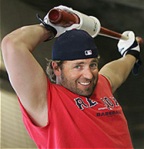 Kevin Millar played for the Marlins between 1998 and 2002, and was later sold to the Japanese Central League Chunichi Dragons. In order for the transaction to be completed, he first had to clear the waivers requested by the Marlins, but the Red Sox broke an “unwritten rule” and blocked the deal with a waiver claim. In an unprecedented deal brokered by MLB, the Marlins later repaid the money that the Dragons had paid for Millar, and the Sox also paid a similar sum to the Marlins in return for Millar. He became a clubhouse favorite and a sort of cult hero for the Red Sox fans because of his iconic “Cowboy Up” rallying cry. His clubhouse presence and offensive production helped spark the Red Sox to the 2003 American League Championship Series and the 2004 World Series. Millar was active in team interviews and conversations throughout the playoffs. He was often outspoken and made friends with many teammates. During the 2003 playoffs, Millar came up with the phrase “Cowboy Up,” and in 2004 referred to his team as “idiots” to keep his teammates loose during the stretch run to the World Series Championship. Probably one of his most memorable quotes came during the 2004 American League Championship Series when, while warming up before Game 4, with the Red Sox down 3 games to 0 against the arch-rival New York Yankees, he kept repeating “Don’t let us win tonight!” Further developing on that quote, he added “This is a big game. They’ve got to win because if we win we’ve got Petie coming back today and then Schilling will pitch Game 6 and then you can take that fraud stuff and put it to bed. Don’t let the Sox win this game.” These words became prophetic as the Sox rallied in 12 innings in game 4 to win 6-4 and went on to come from behind and win the ALCS 4 games to 3, capping off the biggest comeback in MLB playoff history and setting the stage to bring about death to the Curse of the Bambino. Jersey # 15
Kevin Millar played for the Marlins between 1998 and 2002, and was later sold to the Japanese Central League Chunichi Dragons. In order for the transaction to be completed, he first had to clear the waivers requested by the Marlins, but the Red Sox broke an “unwritten rule” and blocked the deal with a waiver claim. In an unprecedented deal brokered by MLB, the Marlins later repaid the money that the Dragons had paid for Millar, and the Sox also paid a similar sum to the Marlins in return for Millar. He became a clubhouse favorite and a sort of cult hero for the Red Sox fans because of his iconic “Cowboy Up” rallying cry. His clubhouse presence and offensive production helped spark the Red Sox to the 2003 American League Championship Series and the 2004 World Series. Millar was active in team interviews and conversations throughout the playoffs. He was often outspoken and made friends with many teammates. During the 2003 playoffs, Millar came up with the phrase “Cowboy Up,” and in 2004 referred to his team as “idiots” to keep his teammates loose during the stretch run to the World Series Championship. Probably one of his most memorable quotes came during the 2004 American League Championship Series when, while warming up before Game 4, with the Red Sox down 3 games to 0 against the arch-rival New York Yankees, he kept repeating “Don’t let us win tonight!” Further developing on that quote, he added “This is a big game. They’ve got to win because if we win we’ve got Petie coming back today and then Schilling will pitch Game 6 and then you can take that fraud stuff and put it to bed. Don’t let the Sox win this game.” These words became prophetic as the Sox rallied in 12 innings in game 4 to win 6-4 and went on to come from behind and win the ALCS 4 games to 3, capping off the biggest comeback in MLB playoff history and setting the stage to bring about death to the Curse of the Bambino. Jersey # 15
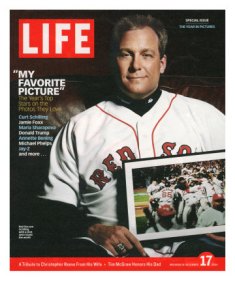 Curt Schilling began his professional career in the Red Sox farm system as a second-round pick in what would be the final January draft in MLB. He began his professional career with the Elmira Pioneers, a then Red Sox affiliate. After two and a half years in the minor leagues, he and Brady Anderson were traded to the Baltimore Orioles in 1988 for Mike Boddicker. In November 2003, the Diamondbacks traded Schilling to the Boston Red Sox. The trade to Boston reunited Schilling with Terry Francona, his manager during his final four years with the Philadelphia Phillies. This move meant Schilling and Francona have been part of the rivalries of both New York City baseball teams, though neither were on the New York side (New York Yankees vs. Boston Red Sox and New York Mets vs. Philadelphia Phillies).
Curt Schilling began his professional career in the Red Sox farm system as a second-round pick in what would be the final January draft in MLB. He began his professional career with the Elmira Pioneers, a then Red Sox affiliate. After two and a half years in the minor leagues, he and Brady Anderson were traded to the Baltimore Orioles in 1988 for Mike Boddicker. In November 2003, the Diamondbacks traded Schilling to the Boston Red Sox. The trade to Boston reunited Schilling with Terry Francona, his manager during his final four years with the Philadelphia Phillies. This move meant Schilling and Francona have been part of the rivalries of both New York City baseball teams, though neither were on the New York side (New York Yankees vs. Boston Red Sox and New York Mets vs. Philadelphia Phillies).
On September 16, 2004, Schilling won his 20th game of the 2004 for the Red Sox, becoming the fifth Boston pitcher to win 20 or more games in his first season with the team, and the first since Hall of Famer Dennis Eckersley in 1978. Schilling ended his regular season with a 21–6 record. On October 19, 2004, Schilling won Game 6 of the 2004 American League Championship Series against the New York Yankees. Notably, he won this game playing on an injured ankle—the same injuries that contributed to his disastrous outing in Game 1 of the ALCS. These injuries were so acute that by the end of his performance that day his white sock was soaked with blood, which is now referred to as “the bloody sock”. The win forced a Game 7, making the Red Sox the first team in MLB history to come back from a three-games-to-none deficit. The Red Sox would go on to win Game 7 and the ALCS and make their first World Series appearance since 1986. Schilling pitched (and won) Game 2 of the 2004 World Series for the Red Sox against the St. Louis Cardinals. In both series, he had to have the tendon in his right ankle stabilized repeatedly, in what has become known as the Schilling Tendon Procedure, after the tendon sheath was torn during his Game 1 ALDS appearance against the Los Angeles Angels. As in Game 6 of the ALCS, Schilling’s sock was soaked with blood from the sutures used in this medical procedure, but he still managed to pitch seven strong innings, giving up one run on four hits and striking out four. This second bloody sock was placed in the Baseball Hall of Fame after Boston’s victory over St. Louis in the World Series. A four-game sweep of the World Series erased the Curse of the Bambino. Schilling was once again runner-up in Cy Young voting in 2004, this time to Minnesota Twins hurler Johan Santana, who was a unanimous selection, receiving all 28 first-place votes. Schilling received 27 of the 28 second-place votes. Later, the entire Red Sox team was named Sports Illustrated’s 2004 Sportsmen of the Year, making Schilling only the second person to have won or shared that award twice.
In 2006 he began the season 4–0 with a 1.61 ERA. He finished the year with a 15–7 record and 198 strikeouts, with a respectable 3.97 ERA. On May 27, he earned his 200th career win, the 104th major league pitcher to accomplish the feat.On August 30, Schilling collected his 3,000th strikeout. Schilling has the highest ratio of strikeouts to walks of any pitcher with at least 3,000 strikeouts, and is one of four pitchers to reach the 3,000-K milestone before reaching 1,000 career walks. The other three who accomplished this feat are Fergie Jenkins, Greg Maddux, and former Boston Red Sox ace and teammate Pedro Martínez. On June 7, 2007, Schilling came within one out of his first career no-hitter. Schilling gave up a two-out single to Oakland’s Shannon Stewart, who lined a 95-mph fastball to right field for the A’s only hit. Schilling continued his career postseason success in 2007, throwing seven shutout innings in a 9–1 victory over the Angels in the ALDS, wrapping up a three-game sweep for Boston. However, he did not fare as well pitching in Game 2 of the ALCS against Cleveland, surrendering nine hits—two of them home runs—and five earned runs in just 4 2/3 innings. He did start again in the sixth game of the series, pitching seven complete innings during which he recorded five strikeouts, surrendering no walks with only two earned runs to gain the victory and force a Game 7. He earned his third win of the 2007 playoffs in Game 2 of the 2007 World Series leaving after 5 1/3 innings, striking out four while allowing only four hits. With this win, he became only the second pitcher over the age of 40 to start and win a World Series game (Kenny Rogers became the first just one year prior). As Schilling departed in the 6th inning, fans at Fenway Park gave Schilling a standing ovation in what would eventually be his final game. Schilling retired with a career postseason record of 11–2. His .846 postseason winning percentage is a major-league record among pitchers with at least 10 decisions. Jersey # 38
